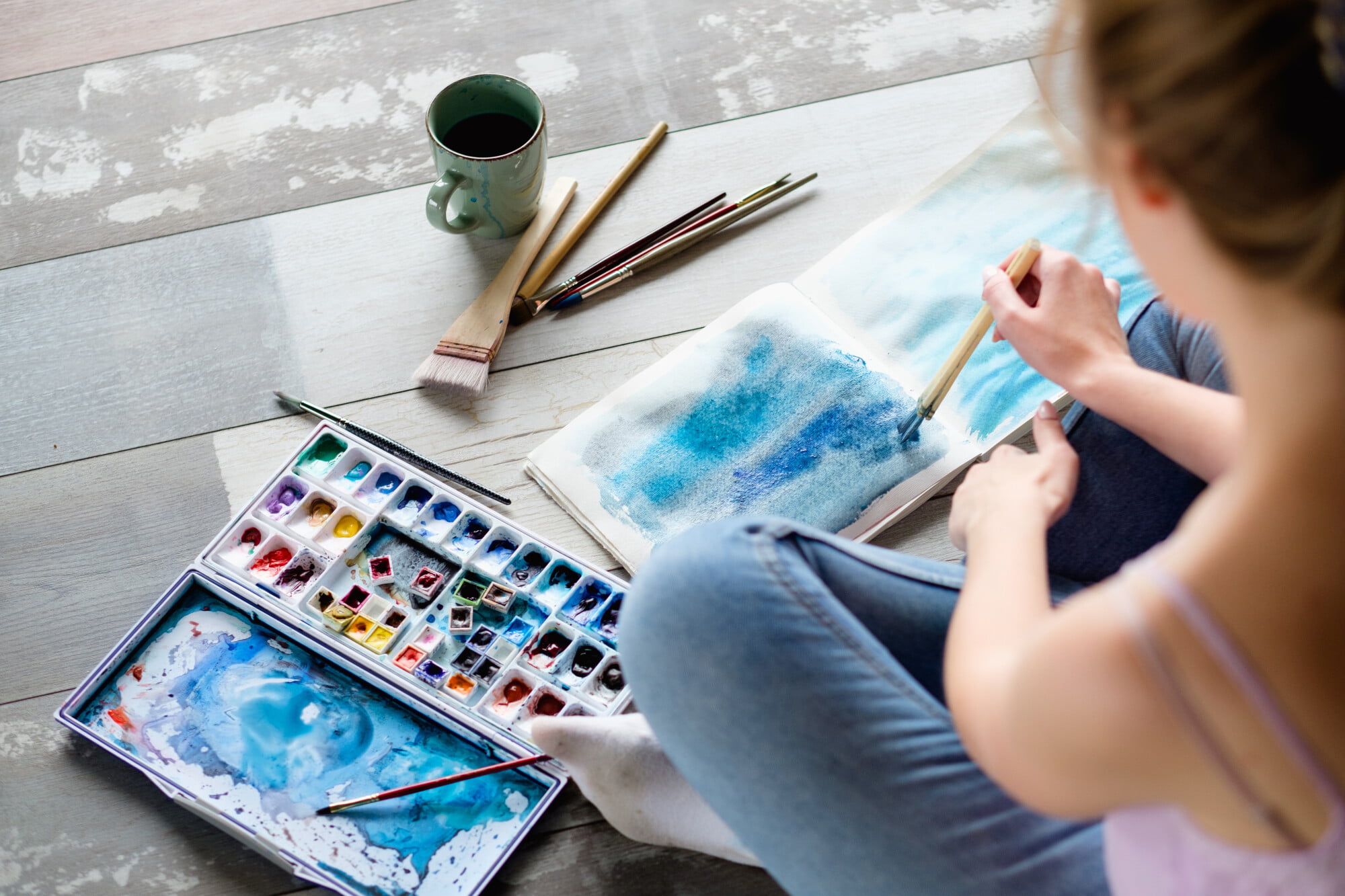Raising a teen with substance dependence can be a stressful and heartbreaking experience. As a parent, you want your teen to be healthy, happy, and living life to the fullest. Approximately 15% of young adults and almost 4% of youth struggle with substance dependence. These numbers show that this is a more common occurrence than we may think. But there is a solution. Recovery centers can be an effective method of treatment for teens with substance dependence. Through evidence-based therapy, teens can deal with their emotions and heal from addiction. Art therapy for teens, in addition to music therapy, are exciting aspects of the treatment plan.
Read on to learn more about the benefits of our art and music therapy programs.
What is Art Therapy?
Art therapy combines art and psychology to help those who struggle with emotional and psychological issues. Through the creative process, the individual is better able to express their feelings. They can also work through internal conflict more easily.
Art therapy is not just for the artistically gifted. There are no artistic skills or art theory knowledge required. The method uses the creative process, self-made art, and art created by others.
The goal of art therapy is to help teens in the following ways:
- express emotions
- solve internal conflicts
- raise self-esteem
- improve general mood
- reduce stress and pain
- restore focus
- boost communication
Art therapy can be a beneficial outlet for teens struggling with substance dependence. There is often comorbidity between substance abuse and other mental health disorders. For example, anxiety and depression are common in teens with addiction issues.
Art Therapy Activities for Teens
Numerous art therapy techniques and methods are used in treatment programs. Since art therapy has become an important part of recovery programs, a variety of materials are available. Teens can choose to work with any medium that interests them.
Some common mediums used in art therapy for teens include:
- working with clay
- painting and finger painting
- doodling and scribbling
- working with fabrics
- making collages
- mixed material sculptures
Oftentimes, art therapy may cause repressed internal thoughts to surface. Since trauma is often at the center of many mental health disorders, teens may feel uncomfortable talking about it.
Art therapy provides a non-verbal outlet through creative expression. It can be a full-body experience; connecting the mind, the spirit, and the body. Teens may feel more comfortable expressing their ideas, thoughts, and emotions.
Benefits of Art Therapy for Teens
Studies have found significant positive effects of art therapy on mental health struggles. There was a major reduction in anxiety and depression. Self-esteem and general mood showed improvement as well.
Art therapy also includes group activities for teens, helping them to work on social skills and communication. Group activities are key in encouraging teens to open up and talk about their emotions. Through group art therapy teens can find a sense of family and community.
There are some specific benefits related to mental health struggles often found alongside addiction. Let’s take a closer look.
Substance Dependence
Art therapy can benefit teens with substance dependence by helping them in a non-verbal way. They can examine their history, triggers, and trauma in a more comfortable environment.
Studies have found that art therapy can help individuals with addictions by:
- decreasing shameful feelings
- removing resistance to treatment
- improving communication
- decreasing denial of issues
Anxiety and Depression
Teens with substance dependence issues have a higher risk of anxiety and depression. Art therapy can help reduce anxiety by providing an outlet for anxious thoughts. It can also lessen the effects of depression, improve mood, and increase motivation.
Trauma
Traumatic events can sometimes begin a cycle of substance abuse and traumatic stress. Art therapy directs the focus to introspection and dealing with internal conflict. Dealing with internal conflict is the first step in healing past trauma and learning coping tools for the future.
Relationship Issues
Relationship or family issues can lead to substance abuse for teens. Art therapy can be individual, group-focused, or for the whole family.
Family members can work through their conflicts together in a safe environment. This often reduces the pressure associated with family therapy.
What is Music Therapy?
You may have searched “music therapy near me” as a way to find solutions for your teen. But what is music therapy exactly and how does it help?
Music therapy is a newer technique in substance abuse treatment. We all know the importance of music for teens. Music therapy uses positive music to encourage teens to focus on self-expression.
Music lyrics are an important aspect of music therapy. Teens often use songwriting as a method of introspection and self-expression. Lyric analysis can also help teens identify with emotions that are hard to express.
Relaxation techniques are often taught through melodies. Melodies can provide a source of familiarity and stability. Stability can ease stress and provide comfort in the recovery environment.
Music Therapy Activities
Music therapy activities are a planned part of the treatment process. They vary based on needs, goals, and preferences. Let’s look at some common activities used in music therapy.
Songwriting
Songwriting has an especially meaningful impact on internal conflict. It’s often easier to write down intense feelings than speak them out loud. Songwriting provides a simple outlet for these emotions.
It also allows for using metaphors and abstract descriptions. When an individual isn’t in touch with their emotions, speaking indirectly can be a better option. This is especially true when their emotions are too difficult to access.
Lyric Analysis
Lyrics analysis is a great way to identify with emotions that are hard to express. The words are already written so teens may find it to be a non-invasive way to share their thoughts.
Just the idea of knowing that someone else feels the same emotions can be comforting. Substance dependence and mental health disorders can often feel isolating. Finding relatable lyrics can help teens feel less alone.
Improvisation
Planned activities and achieving recovery goals can be a source of stress. Music improvisation provides a sense of freedom and a low-pressure environment.
Teens can improvise lyrics and melodies based on in-the-moment emotions and thoughts. The pressure to perform and the stress of saying the right thing disappears.
Benefits of Music Therapy for Teens
Because music is a non-invasive medium, the benefits of music therapy can be amazing. Teens don’t have to be skilled, or even knowledgeable in music theory, to take part. Freedom of expression is highly encouraged.
Some common benefits associated with music therapy include:
- improved self-confidence
- higher focus and motivation
- greater self-expression
- increased communication
- safe space for emotional processing
- less stress and mood swings
- finding commonalities
Teens in the music therapy program can take advantage of individual or group classes. Individual music therapy lowers pressure and provides a safe environment to heal. Group music therapy can increase bonding, social skills, and communication with others.
Choosing the Right Recovery Treatment
Choosing the right recovery center is crucial in helping your teen heal from substance dependence. With so many options and approaches available, which is the right choice?
The right recovery center will have a clearly defined philosophy and approach. Parents should feel confident that their beliefs align with the center’s treatment program.
We offer a fully developed treatment program that is focused on healing and inspiring teens. In addition to dealing with the present, we also focus on the future. Coping methods and techniques, as well as real-life skills, are a big part of our program.
Our program also places importance on nature and the arts. Teens will participate in art therapy and music therapy as part of the treatment. But we also offer other therapeutic activities for teens such as wilderness programs and equine-assisted therapy.
These holistic programs ensure that spiritual, creative, and emotional needs are met. Teens who participate in these programs may also discover hobbies and passions that they had long forgotten.
Recovery centers should be a safe space for teens to explore their emotions, desires, and future goals. When choosing the right space, asking important questions is critical. Once you have all the information, making an informed decision is much easier than you think.
On the Road to Recovery
Substance dependence can affect anyone, regardless of age. When it’s your teen suffering, the emotional and mental stress is especially draining.
Finding a safe and encouraging recovery center can be the most welcome relief. Through evidence-based techniques like art therapy for teens, healing is achievable. The right combination of individual, group, and family therapy is ideal for success.
If you need more information on evidence-based therapy, please contact us at (678)833-3974 . We’re ready to answer any questions you may have.
Convinced that Eagle Outlook Recovery Center is the perfect place for your teen’s healing process? Please contact us today. We’ll walk you through every step of the process.

